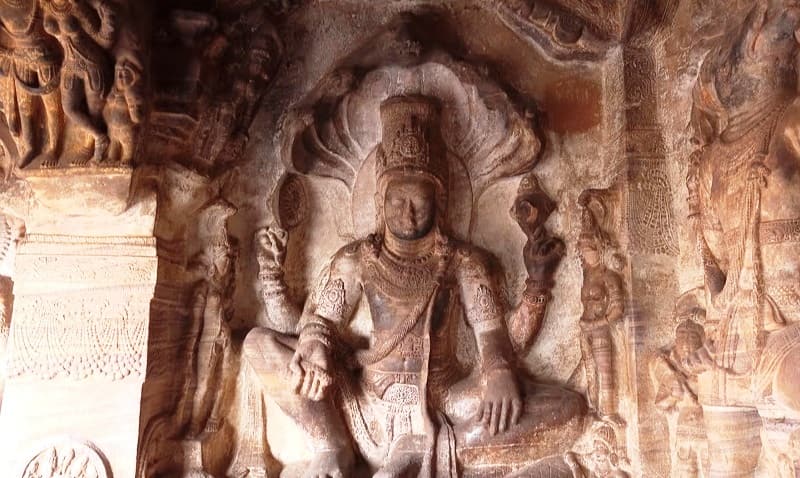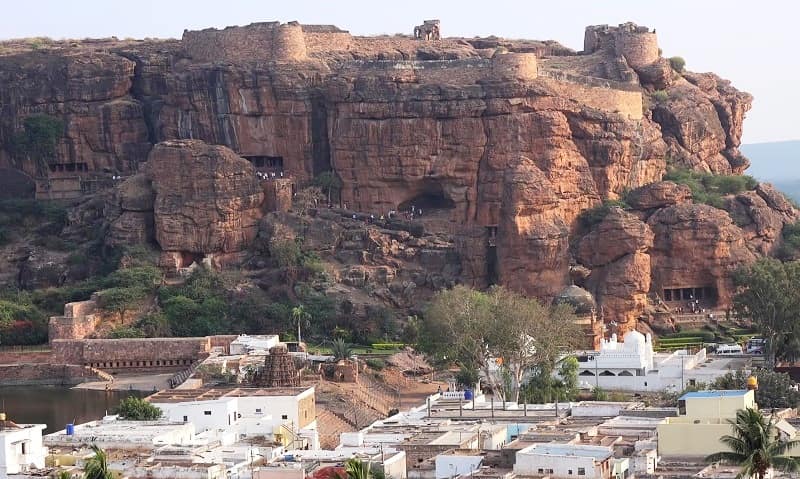Badami, which was the capital of the early Chalukya dynasty of South India, ruled much of Karnataka from the 6th to the 8th century, is currently known for its historical heritage. This historic city was once referred to by its mythical name Vataapi Badami and today, it is famous all over the world for many archaeological monuments of Badami Chalukya. It was founded by the first ruler of the Chalukya dynasty, Pulakeshin I in 540 A.D. Badami is mainly known for its beautiful cave temples, a complex of Hindu and Jain cave temples, and which are considered an example of Indian rock-cut architecture.
Actually, these cave temples are huge sandstone rock formations that have been given a very beautiful attractive appearance. The escarpment is above a man-made lake called Agastya Teertha. These rock carved structures are worth seeing and one can easily understand the Chalukya architecture closely in these temples. These historic temples are surrounded by huge rocky valleys and you can see a mixed form of North-South Indian architectural style here. This temple complex has four caves, 3 belonging to Hinduism, and one to Jainism, all of which were built by the two sons of Pulakeshin I - Kirttivarman and Mangalesha. All the temples share the same architecture - a veranda supported by stone columns and brackets leading to the columned main hall (Maha Mandapa), which led to the sculpture's construction. There are around 2000 stairs that have to be climbed to reach these caves.
Cave 1 is dedicated to various sculptures of Hindu divinities, especially Lord Shiva. This attractive cave portrays the Tandava-dancing Shiva as Nataraja, along with many other carvings including Ganesha and goddess Durga slaying the buffalo-demon Mahishasura. Cave 2 is quite similar to Cave 1 in terms of its layout and design, featuring Hindu themes, with Vishnu's sculpture in the magnificent form of Trivikrama being the largest. Cave 3, which is the largest and beautiful cave of the complex, featuring Vishnu-relate. It represents the giant figures related to Trivikrama, Anantasayana, Vasudeva, Varaha, Narasimha, and Harihar - half Vishnu and half Shiva. The fourth cave to the east of Cave 3 is dedicated to revered figures of Jainism. A scenic image that adorns the sanctum sanctorum in this cave is that of Mahavira. Apart from this, other carvings include Padmavati and other Tirthankaras, etc. The interior decoration of these temples, made by cutting of solid rocks, is unique, which is visited by thousands of devotees to see it.
Along with the cave temples, you can see the historical Badami fort here, which is now left here for its archaeological importance in the form of ruins. This fort was built by the Chalukya king Pulakeshin in 543 AD. History suggests that this fort was destroyed by the Pallava dynasty in 642 AD. However, even today, you can find the grandeur of that fort in the remnants here. Tourists visiting Karnataka for a historical tour can come here.
Apart from the above-mentioned sites, you can also see Malegitti Shivalaya here. It is a historic temple dedicated to Mahadev, Lord Shiva, which was built on a ridge of the rugged hills. The beauty of this temple is worth seeing from where you can enjoy the amazing views of Badami.
















0 comments:
Post a Comment